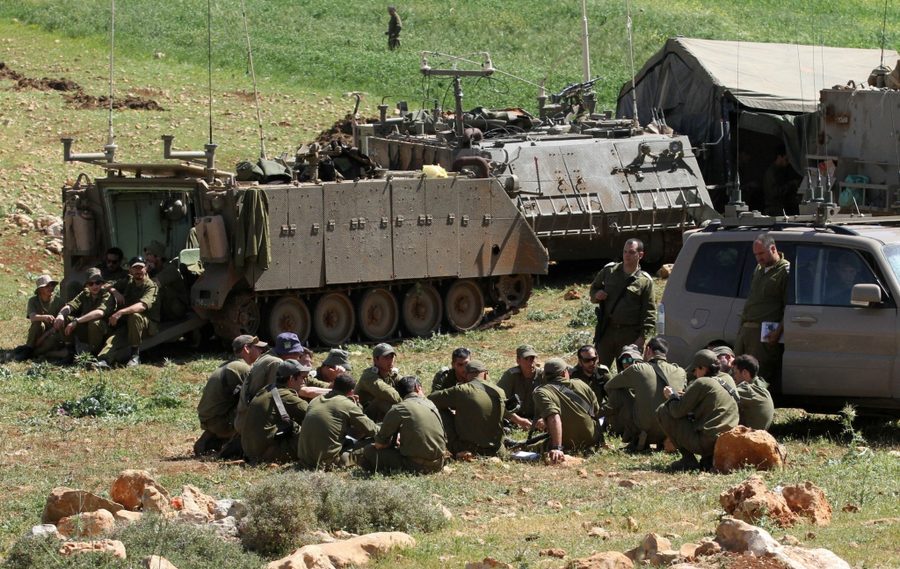Ethnic Cleansing Campaigns Like Sheikh Jarrah Are Nothing New for Israel
An In These Times feature from 1977 examining the proliferation of illegal settlements across the occupied territories has proved distressingly prescient.
Maryum Elnasseh

The Israeli Supreme Court delayed an appeal hearing on May 9 that aimed to halt the eviction of at least six Palestinians families from the East Jerusalem neighborhood of Sheikh Jarrah. A settler group is trying to seize the land in accordance with a discriminatory 1970 law that allows Jewish Israelis to claim property owned before 1948 while preventing Palestinians from doing the same. (Local organizers launched a Save Sheikh Jarrah campaign online in March in an effort to build international support for their cause.)
The following day, Israeli security forces raided Islam’s third holiest site, the Al-Aqsa Mosque, where thousands of worshippers had gathered to pray during their holy month of Ramadan. The raid injured more than 300 Palestinians, and Hamas, which controls the Gaza Strip, responded by firing rockets into Israel for the first time since 2014. As of this writing, Israel’s retaliatory airstrikes have left at least 103 Palestinians dead, including 27 children.
Ethnic cleansing of the sort we’re witnessing in Sheikh Jarrah is as old as the state of Israel itself. During the nation’s founding in 1948, Zionist militia forcibly removed no fewer than 750,000 Palestinians from their homes — an expulsion that Palestine recognizes as “Nakba,” Arabic for “catastrophe.” Nineteen years later, when the Israeli military occupied Gaza, East Jerusalem and the West Bank, along with the Golan Heights in Syria, it displaced nearly 400,000 more. In Sheikh Jarrah alone, Israel has conducted separate eviction campaigns in 2002, 2008 and 2017; many of those facing eviction today are the descendants of refugees themselves.
Last November, Israel’s Jerusalem District Court ordered the removal of 87 Palestinians from their homes in Silwan, a separate neighborhood in East Jerusalem. Several of the evicted families had lived there since 1963. The court’s ruling favored Ateret Cohanim, a far-right settler group whose stated mission is to move Jews into the Christian and Muslim neighborhoods of Jerusalem. Approximately one thousand Palestinians across occupied East Jerusalem are currently at risk of losing their homes to Israeli settlers.
“Last year was the highest rate of settlement expansion in the East Jerusalem on record — about 4,500 units,” Zakariah Odeh, the director of the Civic Coalition for Palestinian Rights in Jerusalem, recently told Al Jazeera. “The year 2020 also saw 170 Palestinian structures demolished, including 105 homes, which resulted in the displacement of 385 people.”
Writing for In These Times in October 1977, David Mandel examined what he called “Israel’s 77 unsettling settlements.” These settlements, illegal under international law, have ballooned to more than 200 in the decades since — a grim development that Mandel’s piece anticipated.
TEL AVIV — It is getting increased UN attention and has caused a crisis in U.S./Israel relations. But the question of Jewish settlements in the territories occupied since 1967 is not a new one. The Labor government, in power until this summer, approved and founded 77 such settlements — with American acquiescence.
Why then all the furor over the new Likud government’s plans? Its “ideological” motivation, asserting the right of Jews to dwell in all parts of historic Israel, will undoubtedly be limited by tactical and logistic considerations.
… So why the fuss?
Pressure for a peace settlement, requiring withdrawal from the territories, is mounting. The 77 existing settlements constitute a major obstacle, and undoubtedly would have become a bone of contention had Labor stayed in power.
… The Labor government claimed to be settling only unpopulated areas. While it is true that the most densely populated Arab areas are still untouched, the claim is far from accurate. Two of the most well known counter-instances are the Pithat Rafiah area, where thousands of nomadic Bedouin families were rounded up and fenced into several small reservations to make way for the sprinkling of new settlements now flourishing there, and the West Bank town of Akraba, whose fields were sprayed with poison and closed “for military reasons” in 1972, only to become the site of one of the western-most “Jordan Valley” settlements. Both episodes stirred up active protest by leftist groups in Israel and, eventually, some unfavorable press comment.
Any Likud plans to broaden settlement projects will inevitably come into more direct conflict with Arab inhabitants, whose spring 1976 civil uprising was sparked, in part, by Gush Emunim’s successfully forcing the Rabin government to allow it to settle at Kadum, six miles from Nablus. Ironically, however, even the new, nonspecific plan outlined recently by Agriculture Minister Ariel Sharon still avoided the most populated centers of Arab population; it only slightly widened the previous Allon [Labor] Plan
… The internal Israeli debate over “how much” of the territories to keep and where to settle becomes nearly irrelevant when faced with the Arab, and now most of the world, consensus that all the occupied lands must be returned as part of any peace agreement, and that such a peace agreement is crucial to world peace.
… The present government’s insistence on continued rule over another people against their will — at most offering extremely limited “home rule”— can only spark greater resistance on the part of the Palestinians, and sooner or later, is likely to lead to more war, which in turn can only continue to harden attitudes and bring even greater suffering to both Palestinians and Israelis.
Maryum Elnasseh is a writer based in Richmond, Virginia and an editorial intern with In These Times. She graduated last year from Virginia Commonwealth University with dual degrees in journalism and political science.






